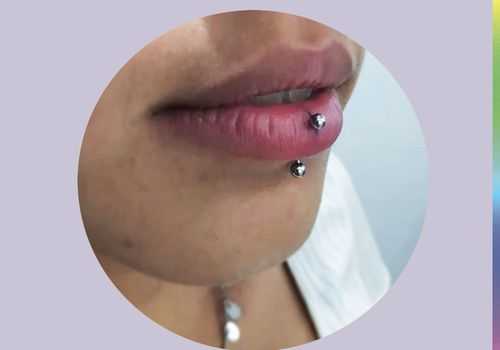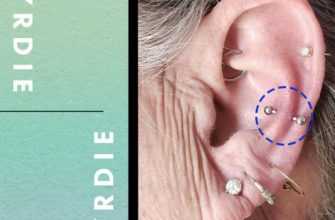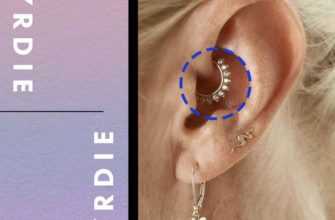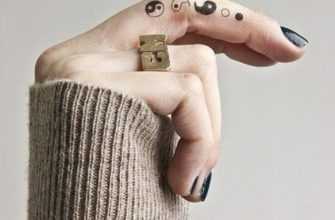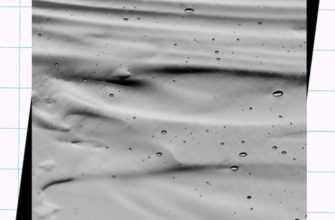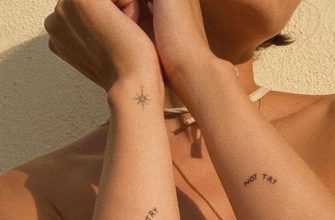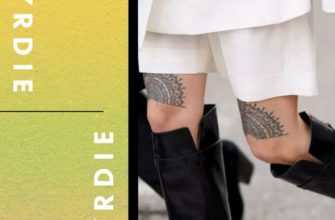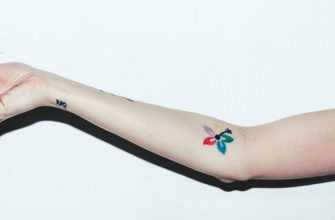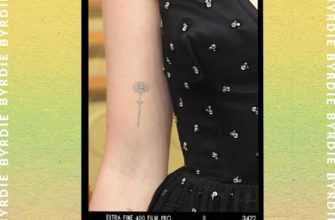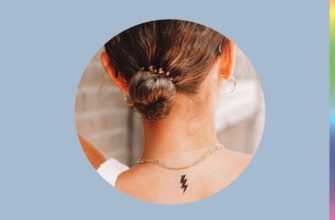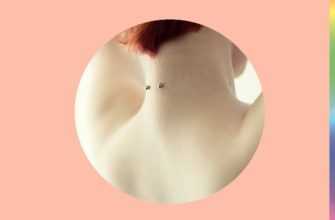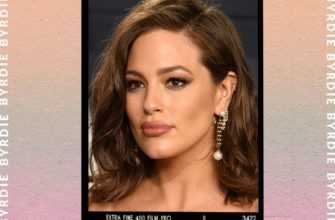What Is a Vertical Labret Piercing? Pain and Healing Time Cost Aftercare Side Effects How to Change Out a Vertical Labret Piercing Type of Jewelry Used. If you’re someone who loves to show off their piercings front and center, a vertical labret piercing may be just the body modification for you. Placed directly on your lips, there’s no hiding one of these. However, this makes it a great choice for those who want colorful, personalized jewelry or those who just love piercings.
A labret piercing is pierced through the skin, from the outside of the mouth to the inside just below the bottom lip. And, although it shares half a name, a vertical labret is a completely different piercing entirely. A vertical labret, by contrast, is pierced through the bottom lip and is completely on the outside of the mouth.
For those considering a vertical labret piercing, it’s important to talk to your piercer about whether your lips can support the piercing, whether it matches with your face shape, and how exactly to care for the healing piercing. If you’re interested in getting a vertical labret piercing, read on for a complete guide to everything you need to know.
Vertical Labret Piercing
Placement: Located on the bottom lip
Pricing: $30-$100
Pain level: “This piercing is normally rated around a 4 on a scale of 1 to 10,” says St Peter
Healing time: While healing times may vary, expect a period of 6 to 8 weeks
Aftercare: Wash the area with a sterile sea salt solution two to three times a day until it’s fully healed
What Is a Vertical Labret Piercing?
A vertical labret piercing is a bar pierced vertically through the center of bottom lip. It’s a twist on the basic labret, which is pierced through the skin below the lip and has only the jewelry visible. With a vertical labret, however, the piercing is completely outside of the mouth and both ends of the jewelry are visible.
“Like all piercings, these should always be performed with a needle by a professional,” says Tierney. “The specific technique may vary from piercer to piercer with what they find comfortable to execute a straight piercing.”
And while there is some variation, a typical vertical labret piercing process involves marking the skin, holding the lip in place with a pair of slotted sterile forceps, and piercing the lip in a downward motion with a needle in the appropriate gauge.
It’s important to note, however, that vertical labret piercings don’t work for everyone. If you’re considering the piercing, do your research and talk to your potential piercer. Being open and honest about how your face is shaped or any alterations you may have had done (anything from plastic surgery to other facial piercings) can help to ensure that your vertical labret piercing looks exactly as it’s supposed to.
“This is a piercing that depends very heavily on anatomy; it is not one that everyone is going to be able to support,” says Tierney. “Never take it personally if your piercer says your anatomy will not support a particular piercing—they are just looking out for you and want the best results for you.”
Pain and Healing Time
It’s hard to pinpoint exactly how much a piercing will hurt, considering it’s so dependent on personal pain tolerance and your piercer’s process. St Peter says you can expect a sharp pinch, but that the pain will quickly subside.
“Pain is relative; piercings are always going to have some degree of pain but everyone is going to respond and experience that pain differently,” agrees Tierney. “Never put off a piercing you want out of fear of it hurting! They are always super fast and never as bad as we make ourselves believe.”
Healing times for vertical labret piercings vary based on how you care for it and your own body. At a minimum, says St Peter, your new piercing will require 6 to 8 weeks. Tierney agrees, noting that she likes to suggest “around four to six months as a minimum”—just so you can be sure your new piercing is definitely healed.
However, because vertical labret piercings don’t touch the inside of your mouth at all, there’s less healing time than, say, a normal labret piercing, according to Gabriela Soza, MD, a board-eligible dermatologist at Sadick Dermatology.
“The piercing also stays relatively cleaner during healing since you don’t have to worry about the bacteria in your saliva, and the piercing heals slightly quicker,” says Soza. “In response to injury or trauma, lips heal quite well given the vasculature of the tissue.”
Cost of a Vertical Labret Piercing
The price of a vertical labret piercing isn’t as simple as a one-time payment; instead, it’s a piercing that involves a process. After the actual piercing—which will vary in price depending on where your studio is located and the piercer themself—you also have to pay for the jewelry used in the initial appointment. Something else that many people may not know is that vertical labret piercings require a lot of jewelry downsizing during the healing process, meaning you may have to pay for jewelry a few more times over the course of six to eight weeks or so. Be sure to talk to your piercer about the process they envision and just how much they expect that to cost.
“I charge $40 including the jewelry, but you can find shops charging anywhere from $30 to $100 for this piercing,” says St Peter.
Aftercare
Aftercare for a vertical labret is pretty typical for piercings: clean the area with a sterile saline solution two to three times a day for the entire healing process. Unfortunately, while the actual direct care seems simple, there is a lot of protocol that has to be stuck to during aftercare to ensure nothing happens to your fresh piercing.
The first main precaution is to avoid touching the jewelry as much as possible (it’s okay to touch it while you clean it). If you’re someone who practices skincare or wears makeup, it’s important you keep all of that away from the healing piercing as well. Additionally, don’t rotate your jewelry—according to Tierney, this is a common misconception left over from old aftercare practices. Finally, no smoking or drinking alcohol for at least two weeks after the piercing, says St Peter, as it may cause irritation.
It may be strange to think about your lips so often during the healing process, but by placing a piercing there, you’re committing to keeping the area clean, safe, and clear until it’s fully healed. However, on the flip side, thinking about your lips is key to proper aftercare—especially because we do so much on a day-to-day basis with them.
“Given the location of the piercing, it is at higher risk for trauma and pulling,” says Soza. “Be conscious of any lip biting or pulling to avoid the jewelry getting tugged.”
Side Effects of a Vertical Labret Piercing
- Swelling: “You may experience minor swelling in the first few days,” says St Peter. But if your lip continues to be very puffed up and red past the first week, something else may be wrong. If you see prolonged swelling, talk to your piercer or a doctor immediately. It may not be an infection, but it could easily become one.
- Migration: Migration occurs when your piercing begins to move from its original spot. Noticing moving jewelry as soon as it happens is imperative, as you may be at risk of developing an infection.
- Infection: An infection may sound scary, but they’re really easy to catch if you’re not rigorous with your aftercare. If you see swelling or redness that doesn’t go down, discharge, tenderness, burning, itching, or intense pain, you’re most likely experiencing symptoms of an infection. If you’re wondering if a symptom is normal, you can also reach out to your piercer or a doctor. If anything does seem to be wrong, seek medical help immediately. “If, at any stage during your healing process—or even after—you have concerns, always get in contact with your piercer,” says Tierney. “They are there to help you through the healing, and even long after the piercing has healed. Never rely on Google or friends to diagnose any possible issues—always see a trusted professional piercer.”
How to Change Out a Vertical Labret Piercing
If you decide you’re tired of the jewelry you initially got pierced with, changing out a vertical labret piercing at home is possible. Do not attempt to do so until the piercing is fully healed, however, since you could easily irritate it, cause an infection, or see your piercing site close up while the jewelry is out of it. Once you’re certain it’s healed, change your piercing by removing the ball on one end of the piercing (preferably the top), and threading the new jewelry through directly behind the old one—never leave your piercing hole empty.
If there’s any confusion about the process or you’re just not ready to do it yourself, you can also go to a piercer to get it changed out—normally for a small fee.
“For the first few change-outs, I would suggest seeing your piercer and having them do it for you and explain how to do it and how the jewelry works, as well as what to do if you struggle,” says Tierney. “If you are able to change your jewelry yourself, my main recommendation is to always cover the drain if you are doing it in the bathroom!”
What Type of Jewelry Is Used for a Vertical Labret Piercing?
You may be familiar with what standard barbells look like from modifications like industrial piercings (considering you can see the full thing), but it’s the same jewelry used in a vertical labret. Essentially, a barbell is a metal bar that has a small bead on each ends—one fixed and one adjustable. In a vertical labret piercing, a curved barbell is used, meaning it slightly curves outward to allow it to fit better on the natural shape of your lips.
“Most piercers use a 16 [gauge] or 14 [gauge] curved barbell for this piercing, and the length will be anywhere between 8mm and 12mm long depending on the size of the client’s lip,” says St Peter.
What Jewelry Material Is Used for a Vertical Labret Piercing?
- Implant-grade stainless steel: This type of jewelry is most commonly used for vertical labret piercings because it’s easily customizable and high quality.
- Titanium: “As far as the metal, properly fitted medical-grade titanium is your best bet,” says Soza. Titanium is a great alternative to surgical steel, as it does not contain nickel — so you get all the pros without the con.
- Gold: No matter what kind of gold you choose for your jewelry—yellow, rose, or white gold—it’s imperative that it’s at least 14 karat and no higher than 18 karat to be sure it’s solid enough not to harbor bacteria.
Article Sources Byrdie takes every opportunity to use high-quality sources, including peer-reviewed studies, to support the facts within our articles. Read our editorial guidelines to learn more about how we keep our content accurate, reliable and trustworthy.

